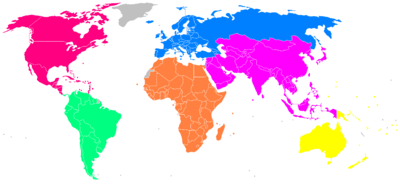Athletics Canada
 | |
| Jurisdiction | Athletics in Canada |
|---|---|
| Founded | 1884 |
| Headquarters | Ottawa, Ontario |
| Chairman | Gordon Orlikow |
| Chief Exec | Rob Guy[1] |
| Sponsor | Sport Canada |
| Official website | |
|
www | |
|
| |
Athletics Canada or AC (French: Athlétisme Canada) is the national governing body of athletics in Canada, which includes track and field, cross-country running, road running, and race walking. Its purpose is the pursuit of leadership, development and competition that ensures world-level performance in athletics. The association believes in physical health and fitness, individual excellence and personal growth, individual development beyond sport, as well as inclusiveness and integrity. Track and field is a sport for people of all ages and abilities.[2]
Athletics Canada is involved in many aspects of the sport at the local, national, and international level – providing the rules, officials, coaching education, sports science and athlete development, youth programs, masters (age 40+) competition, and an annual meeting. It also organizes the annual Outdoor Track and Field Championships and the Indoor Track and Field Championships.
Athletics Canada is a member of the IAAF, IOC, IPC, EAA, NACAC, JDFL, CP-ISRA, CGF, ISBA, FISU and WADA.[3]
Based in Ottawa, Ontario, Athletics Canada is a non-profit organization. The organization is led by an elected board of directors, with a head chairman, currently Gordon Orlikow.[4]
History
The sport governing body for track and field in Canada, which is now called Athletics Canada, was established in 1884. It is one of the oldest affiliated bodies with the International Association of Athletics Federations (I.A.A.F.). Only the association of Great Britain (1880) has been in existence for a longer period of time. New Zealand followed in 1887 and the U.S.A. in 1888.
Following preliminary meetings on April 11, 1884, where the athletics associations of Quebec and Ontario sent some 50 representatives to meet at the Toronto Fencing Club, the principal business was to ratify a constitution for the newly formed Canadian Amateur Athletics Association, the forerunner of Athletics Canada.
A mere seventeen years had passed since Sir John A. Macdonald and the Fathers of Confederation had established the political entity of the Dominion of Canada, but these athletics planners already had a considerable tradition upon which to draw.
The Canadian Track and Field Championships were held in Montreal on September 27 of that year, and 20 years later, Étienne Desmarteau would win the first Olympic gold medal for Canada. George Orton, a Canadian, had won an Olympic gold in 1900, but he was competing at these second Games in Paris on an invitation from the United States.
From 1909 until the fall of 1967, the organization was known as the Canadian Track and Field Association (C.T.F.A.). However, it operated under the umbrella of the A.A.U. of C. (Amateur Athletic Union of Canada). In 1968, the IAAF officially recognized the C.T.F.A as an autonomous group and not part of the A.A.U. of C. The A.A.U. of C subsequently dissolved itself in the early 1970s as all national federations in the different sports went their own ways.
On June 17, 1990, at the annual general meeting of the C.T.F.A., a motion was adopted to change the name to Athletics Canada. The Department of Consumer and Corporate Affairs of the Government of Canada accepted this name change officially on April 12, 1991.
Over the past decade, Athletics Canada has welcomed under its umbrella the high performance athletes for four disability groups: wheelchair athletes joined the association in 1997 with blind, cerebral palsy, amputee athletes following in 2002.
Inclusion of these disability groups was a natural step given that the focus of the association broadened to include the delivery of similar services to all track and field high performance athletes. In the current structure, provincial disability organizations report to their respective national associations - the Canadian Wheelchair Sports Association, the Canadian Blind Sports Association, and the Canadian Cerebral Palsy Sports Association - while Athletics Canada works directly with the national offices of each disability group. [5]
Athletics Canada Championships
- Canadian Track and Field Championships
- Canadian Junior Track and Field Championships
- Legion National Youth Track and Field Championships
- AC Indoor Open
- Canadian Marathon Championships
- Canadian Half Marathon Championships
- Canadian 10Km Road Race Championships
- Canadian 5Km Road Race Championships
- Canadian Cross Country Championships
Organization
Athletics Canada (119472975rr0001) was registered with the Canadian Revenue Agency as a Canadian amateur athletic association (RCAAA); therefore, they can issue official donation receipts and are eligible to receive gifts from registered charities since March 29, 1972.[6]
Provincial governing bodies
Currently there is a branch for all provinces and territories in Canada except for Nunavut.[7]
Kit suppliers
Canada's kit are currently supplied by Nike.
See also
- Sports in Canada
- Canadian records in track and field
- Canadian Track and Field Championships
- Canadian Marathon Championships
- Canadian Half Marathon Championships
References
- ↑ Athletics Canada Staff
- ↑ Mission and Values Archived September 30, 2012, at the Wayback Machine.
- ↑ International Organizations Archived September 30, 2012, at the Wayback Machine.
- ↑ Athletics Canada Board of Directors
- ↑ Athletics Canada History Archived May 23, 2012, at the Wayback Machine.
- ↑ Canadian Revenue Agency
- ↑ Provincial Athletics Associations Archived September 30, 2012, at the Wayback Machine.
| Wikimedia Commons has media related to Athletics Canada. |
External links
- Athletics Canada Official Website
- Athletics Canada Official Facebook
- History of Athletics Canada
- Athletics Canada Rankings
- Policies, Rules, and By-Laws
- Athletics Club Finder
- Canadian Road Championships
- Canadian Cross Country Championships
- Canadian Track & Field Championships
- Canadian Junior Track & Field Championships
- Canadian Youth Track & Field Championships
- National Track League
- Canadian Athletics Records
- AC Issued Newsletters, The Gold Standard

